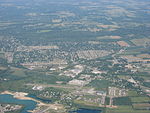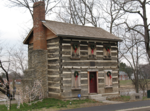Chautauqua, Ohio
Dayton-Springfield-Greenville geography stubsGreater Cincinnati geography stubsPopulated places established in 1901Unincorporated communities in Montgomery County, OhioUnincorporated communities in Ohio ... and 2 more
Unincorporated communities in Warren County, OhioUse mdy dates from July 2023

Chautauqua , also Chautaugua or Chatauqua, is an unincorporated community in Montgomery and Warren counties in the U.S. state of Ohio. Chautauqua is located at 39°35′28″N 84°17′47″W (39.591072, -84.296293). It lies on the west bank of the Great Miami River at the county boundary. It was established in 1901 with 310 acres (1.3 km2). The members of the Miami Valley Chautauqua Association lived in common in the town, occupying about two hundred homes. The Montgomery County portion of Chautauqua is part of the Dayton Metropolitan Statistical Area, while the Warren County portion is part of the Cincinnati–Middletown, OH-KY-IN Metropolitan Statistical Area.
Excerpt from the Wikipedia article Chautauqua, Ohio (License: CC BY-SA 3.0, Authors, Images).Chautauqua, Ohio
Chautauqua Road, Miami Township
Geographical coordinates (GPS) Address Nearby Places Show on map
Geographical coordinates (GPS)
| Latitude | Longitude |
|---|---|
| N 39.591111111111 ° | E -84.296388888889 ° |
Address
Chautauqua Road 10555
45342 Miami Township
Ohio, United States
Open on Google Maps








